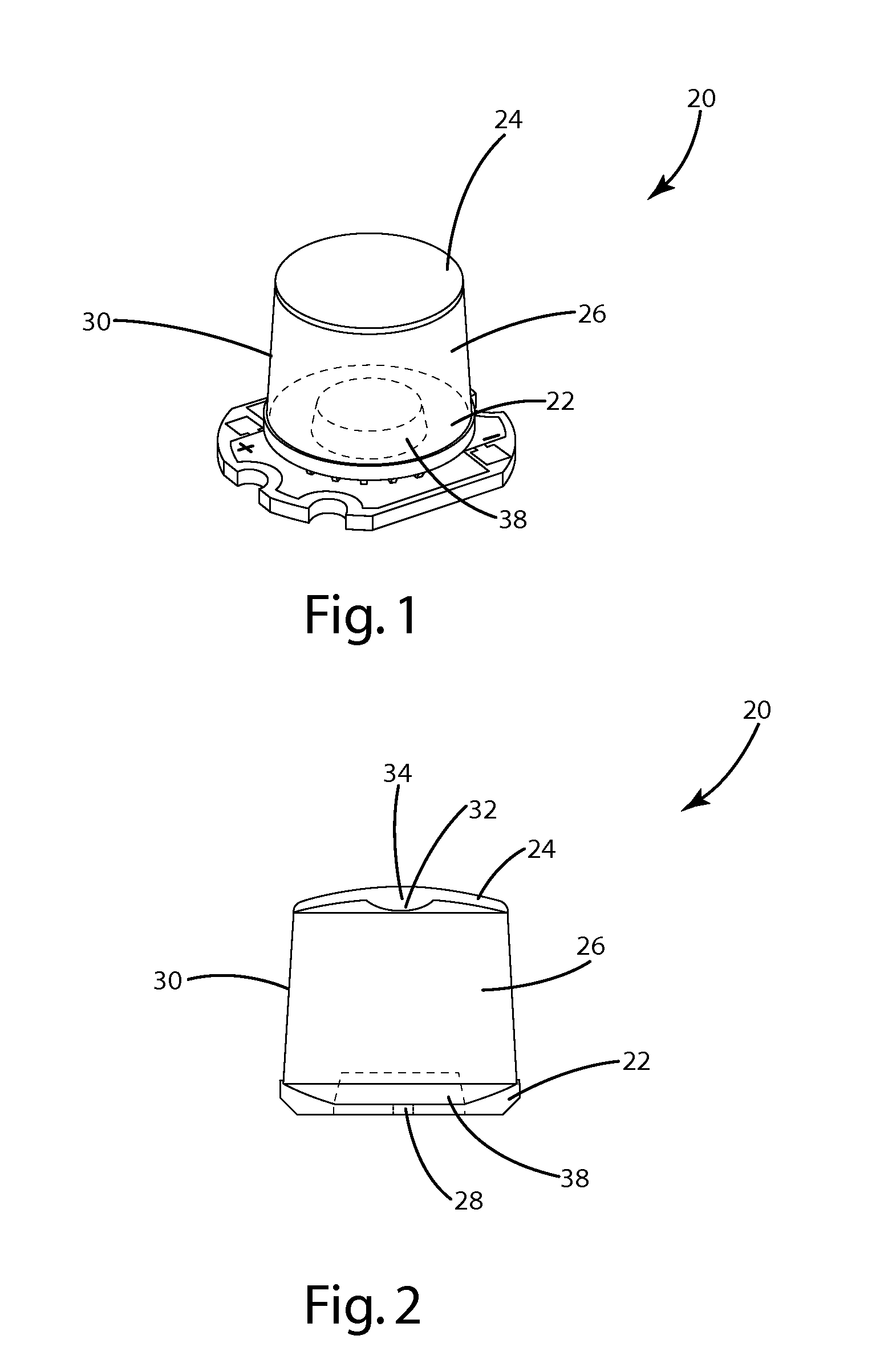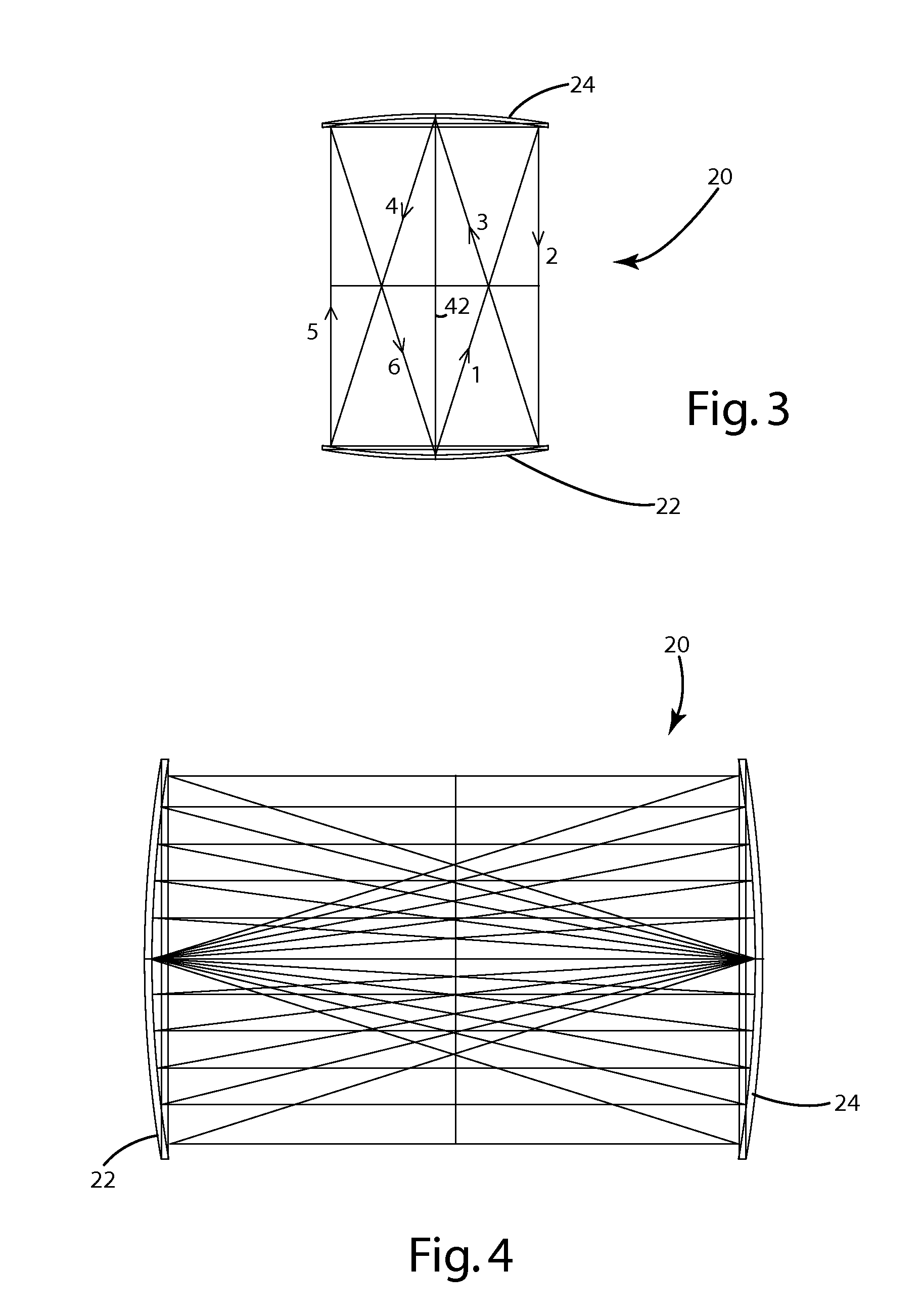Constrained folded path resonant white light scintillator
a scintillator and folded path technology, applied in the direction of discharge tube luminescnet screens, semiconductor devices of light sources, lighting and heating apparatus, etc., can solve the problems of increasing manufacturing costs, hurdling impeding the realization of energy savings, and increasing installation or manufacturing costs, so as to improve utilization and containment of pump light, the effect of reducing the conversion and emission of white ligh
- Summary
- Abstract
- Description
- Claims
- Application Information
AI Technical Summary
Benefits of technology
Problems solved by technology
Method used
Image
Examples
first embodiment
I. First Embodiment
[0035]A volumetric white light emitter in accordance with an embodiment of the present invention is illustrated in FIGS. 1-8 and generally designated 20. The volumetric white light emitter 20 includes a first conic reflector 22, a second conic reflector 24, and a volumetric light conversion element 26 extending between the first conic reflector 22 and the second conic reflector 24. The first conic reflector 22 defines an aperture 28 for a light source or emitter junction (not shown), and the second conic reflector 24 is orientated opposite the first conic reflector for reflecting light from the light source toward the first reflector 22. A convex mirror 32 is positioned adjacent the vertex 34 of the second conic reflector 24. The second conic reflector 24 is shown as parabolic with a focus at the aperture 28 of the first conic reflector 22. Additionally, an elliptical element 38 is positioned adjacent the first conic reflector 22. The elliptical element 38 defines...
second embodiment
II. Second Embodiment
[0041]A folded spherical cavity 50 in accordance with another embodiment of the present invention is shown in FIG. 9. The folded spherical cavity 50 includes a spherical reflector 52, a planar reflector 54 opposite the spherical reflector 52, and a volumetric light conversion element 56 extending between the spherical reflector 52 and the planar reflector 54. The spherical reflector 52 defines an aperture or seat (not shown) for a light source or emitter junction. Though not shown, a convex mirror can be positioned adjacent the planar reflector 54. Additionally, an elliptical element (not shown) can be positioned adjacent the spherical reflector 52. The elliptical element can also include an aperture coincident with the spherical reflector aperture to direct light from the light source toward the planar reflector 54. The volumetric light conversion element 56 includes phosphor particles dispersed in a resin to convert light emitted by the light source from a fir...
third embodiment
III. Third Embodiment
[0042]A folded transverse cavity 70 in accordance with an embodiment of the present invention is shown in FIG. 10. The folded transverse cavity 70 includes a frusto-conical reflector 72, a conic reflector 74 opposite the frusto-conical reflector 72, and a volumetric light conversion element 76 extending between at least a portion of the frusto-conical reflector 72 and at least a portion of the conic reflector 74. The frusto-conical reflector 72 defines an aperture or seat (not shown) for a light source or emitter junction (not shown). The conic reflector 74 is orientated opposite the frusto-conical reflector 72 for reflecting light from the light source toward the frusto-conical reflector 72. A convex mirror 78 is positioned adjacent the vertex 80 of the conic reflector 74. The conic reflector 74 is shown as parabolic with a focus at the aperture of the frusto-conical reflector 72. Though not shown, an elliptical element can be positioned adjacent the frusto-con...
PUM
 Login to View More
Login to View More Abstract
Description
Claims
Application Information
 Login to View More
Login to View More - R&D
- Intellectual Property
- Life Sciences
- Materials
- Tech Scout
- Unparalleled Data Quality
- Higher Quality Content
- 60% Fewer Hallucinations
Browse by: Latest US Patents, China's latest patents, Technical Efficacy Thesaurus, Application Domain, Technology Topic, Popular Technical Reports.
© 2025 PatSnap. All rights reserved.Legal|Privacy policy|Modern Slavery Act Transparency Statement|Sitemap|About US| Contact US: help@patsnap.com



